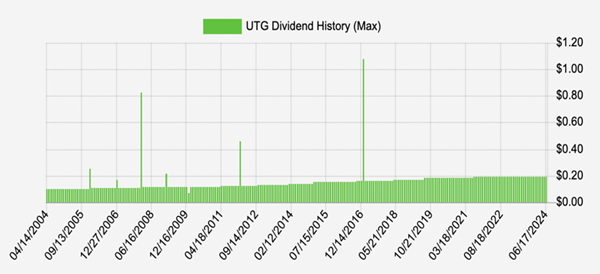When it comes right down to it, there are really only two ways to get rich:
- Through your investments.
- Through your labor.
Let me be clear that we aren’t fans of Option 2. A J-O-B? No thanks! We’re retired—or on our way to it.
Don’t worry. Your income strategist has you covered.
How to Retire on 8%+ Dividends That Roll in “Overnight”
If you’re like me, on your dividend “paydays”—a stock’s payable date, in other words—you wake up, grab a coffee, log into your investment account and immediately do something with that “work-free” income.
Pay your bills, reinvest, drop it into an emergency fund—whatever works for you.
I can practically see you nodding along here. It’s a bit like the old Warren Buffett quote: “If you don’t find a way to make money while you sleep, you will work until you die.”
The 8%+ yielding stocks and funds in our Contrarian Income Report service’s portfolio literally pay us overnight. Plus, many of our CIR holdings drop payouts on us every month.
A Monthly “Morning Coffee” Dividend We Love
 Source: Income Calendar
Source: Income Calendar
The chart above shows the payout from a utility-focused closed-end fund (CEF) CIR members will know: the Reaves Utility Income Fund (UTG). As you can see, UTG’s 8.1%-yielding payout rolls in monthly and has grown steadily since its inception 20 years ago, with special dividends handed out along the way.
Payouts like that make it possible to retire on dividends alone, on a reasonable nest egg. And we’ve got a timely opportunity to buy UTG, and other strong monthly payers, now, thanks to the Fed.
The Fed Is Already Cutting By Stealth
Before we go further, let me just say that we need to take any more Fed “tough talk” on rates we may hear with a grain of salt. Truth is, the economy is slowing, and rates are going to move lower.
Sure, the May jobs report, released last week came in hotter than expected, but the bulk of the gains were in a handful of sectors, and the unemployment rate ticked up to 4% for the first time since January 2022, as the labor-force participation rate slipped.
Meantime, the Labor Department’s Job Openings and Labor Turnover Report for April showed that job openings had fallen to 1.2 per unemployed person. That’s back to where we were in June 2021.
And last week saw the European Central Bank cut rates by a quarter-point, its first reduction since 2019. The Bank of Canada beat the ECB by a day, dropping its key lending rate by a quarter point, marking its first cut since March 2022. You can bet the Fed is paying attention.
Finally, as we discussed a few weeks back, we’ve got Jay pumping money into the banking system through the back door with his shift toward “Quiet QE.”
As rates move lower, bonds—and utility stocks—will rise. Which is where UTG comes in.
The fund focuses on traditional utilities like Maryland-based gas and electricity provider Constellation Energy (CEG) and Entergy (ETG), an electricity producer and distributor in the US South, both of which are among its top-10 holdings. It also has an international flair through holdings like Deutsche Telekom AG and Canadian telcos Telus Corp. (TU) and Rogers Communications (RCI).
The fund applies a bit of leverage (around 20%) to juice returns and deliver its high dividend. That’s conservative, especially when you consider that Reaves can borrow cash for less than you or I can—and its borrowing costs will fall alongside rates.
Reaves, founded in 1961, is a manager after our own hearts. They’re upfront about their formula, posting it right on their website:
- Operate in businesses with high barriers to entry
- Face limited competition / higher regulatory scrutiny
- Consistent, sustainable cash flow generation
- Profitable in both up and down economic cycles
- Dividends viewed as an important component of capital allocation.
I mean, I might have put it a little more conversationally, but we contrarian dividend investors aim for all these things. Reaves’ approach has shown up in UTG’s return (with dividends invested) since its inception in 2004:
UTG Delivers, With Most of Its Gain in Dividends
 A 475% return! And essentially all of it (84%, to be exact) came as dividends.
A 475% return! And essentially all of it (84%, to be exact) came as dividends.
So here’s where the scoresheet stands: We’ve got a strong history, plus a high (and steady) payout and potential upside due to falling rates.
Despite all that, UTG is a relative bargain: The fund trades at a slight premium to net asset value (NAV, or the value of its portfolio) of 2% as I write this. To be sure, we typically demand a discount from our CEF holdings. But UTG’s small premium is nothing new for the fund: It regularly trades at premiums that, in recent years, have wandered as high as 13%!
And once rates start to fall and investors go looking for higher yields, you can bet UTG’s 8.1% payout will get a lot more attention.
— Brett Owens
Yours Now: A Full Portfolio of 8%+ Yielding Monthly Payers [sponsor]
I’ve put my very best monthly paying picks in a unique portfolio I call, simply, the “8% Monthly Payer portfolio.”
I want to give you access to this potent collection of income investments—including a very special fund yielding a stout 10.5%—today. As we just discussed, now is the time to buy high-yielding monthly payers like these, before their prices race away from us. Click here and I’ll tell you all about our monthly dividend strategy and give you VIP access to our full 8% Monthly Payer portfolio.
Source: Contrarian Outlook

